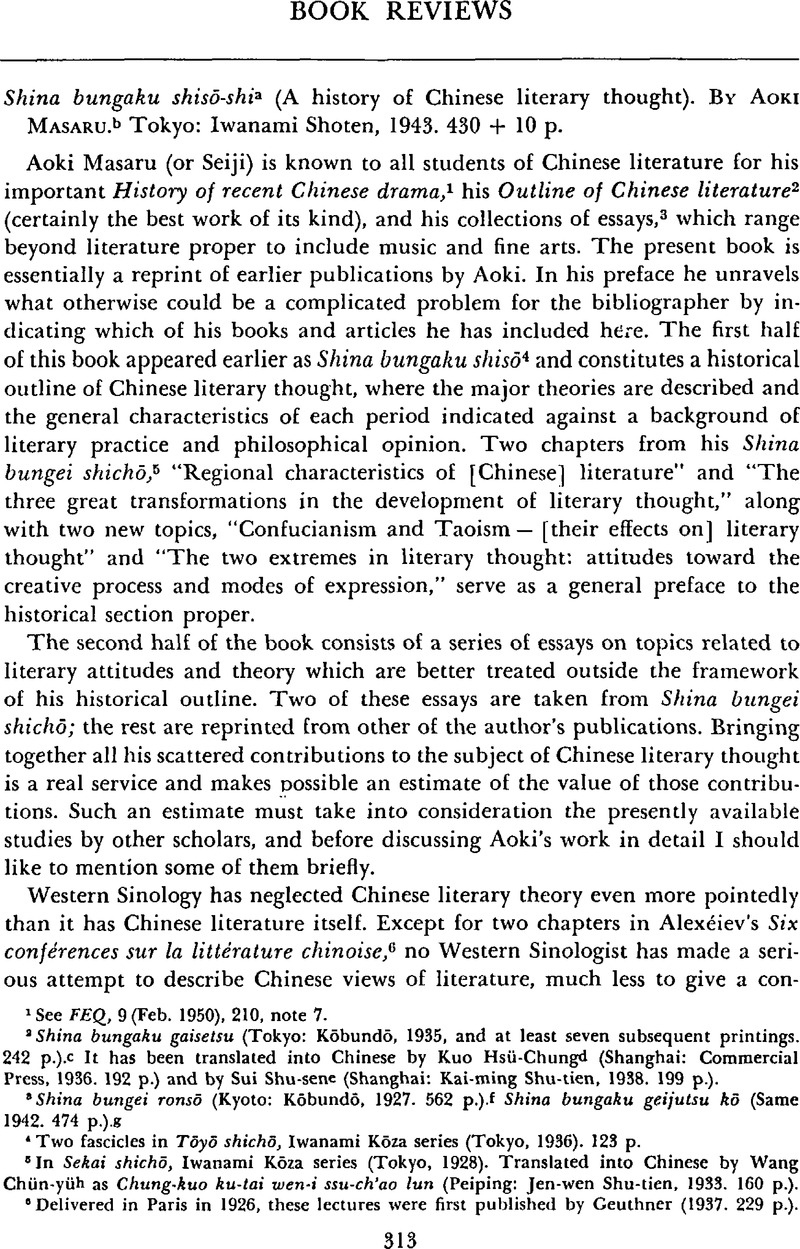No CrossRef data available.
Article contents
Shina bungaku shisō-shia (A history of Chinese literary thought). By Aoki Masaru.bTokyo: Iwanami Shoten, 1943. 430 + 10 p.
Published online by Cambridge University Press: 23 March 2011
Abstract

- Type
- Book Reviews
- Information
- Copyright
- Copyright © Association for Asian Studies, Inc. 1951
References
1 See FEQ, 9 (Feb. 1950), 210, note 7.
2 Shina bungaku gaisetsu (Tokyo: Kōbundō, 1935, and at least seven subsequent printings. 242 p.).c It has been translated into Chinese by Hsü-Chungd, Kuo (Shanghai: Commercial Press, 1936. 192 p.) and by Sui Shu-sene (Shanghai: Kai-ming Shu-tien, 1938. 199 p.).Google Scholar
3 Shina bungei ronsō (Kyoto: Kōbundō, 1927. 562 p.Google Scholar).fShina bungaku geijutsu kō (Same 1942. 474 p.).gGoogle Scholar
4 Two fascicles in Tōyō shichō, Iwanami Kōza series (Tokyo, 1936). 123 p.Google Scholar
5 In Sekai shichō, Iwanami Kōza series (Tokyo, 1928). Translated into Chinese by Chün-yüh, Wang as Chung-kuo ku-tai wen-i ssu-ch'ao lun (Peiping: Jen-wen Shu-tien, 1933. 160 p.).Google Scholar
6 Delivered in Paris in 1926, these lectures were first published by Geuthner (1937. 229 p.)
7 Kyoto: Kōbundō, 1925. 262 p. Translated into Chinese by Liang-kungi, Sun (Shanghai: Pei-hsin Shu-chü, 1929. 140 + 174 p.).Google Scholar
8 Ko-t'iao “ideal form,” Shen-yün “poetic essence,” and hsing-ling “pure feeling.”k These concepts of the poetic essence are to be viewed as norms subscribed to in varying degrees by followers of the many rival schools of poetic theory and practice which flourished in Ming and Ch'ing times. Acceptance of any one usually meant the rejection of the others or their relegation to a subordinate position. They were used more as slogans than as critical terms subject to rigorous definition – the same charge could be made against much of the critical vocabulary of the West – and my translations of these expressions is intended to be suggestive rather than philological.
9 Publisher: Chung-hua Shu-chü. I am relying on Aoki's statement (Kōnan Shun, p. 95) that it was published after 1925.
10 Li Li, whose judgment is usually to be respected, gives the book his highest praise (Santing kuo-hsüeh yung-shu chüan yao, p. 106);m however, he was writing in 1927 and probably did not know Suzuki's work.
11 Shanghai: Commercial Press, 1934. vol. 1, 430 p.; 1947, vol. 2, 652 p.
12 Peiping: Jen-wen Shu-tien, 1934. 350 p.
13 Under the same general title as his earlier work, the four installments are “History of literary criticism of the Chou, Ch'in, and two Han dynasties,” 140 p.; “…of the Wei, Chin, and Six Dynasties,” 142 p.; “…of the Sui and T'ang,” 151 p.; “…of the late T'ang and Five dynasties,” 69 p., Chungking: Commercial Press, 1944, 1943, 1943, 1944. A new edition was printed in Shanghai in 1947.
14 Shanghai: K'ai-ming Shu-tien, 1944. 400 p. An earlier collection of miscellaneous essays by the same author was reprinted from the Wen-che chi-k'anq of National Wuhan University by the same publisher, author's preface dated 1930.
15 Shanghai: K'ai-ming Shu-tien, 1946. One of the K'ai-ming youth library series.
16 Essays, 1–21, see footnote 14 above.
17 Hummel, A. W., Eminent Chinese of the Ch'ing period, 1:164–66.Google Scholar
18 On the origin of the musical scale, see Aoki's detailed study “Gakuritsu Sogen” in Shina bungei ronsō, 86–110.




